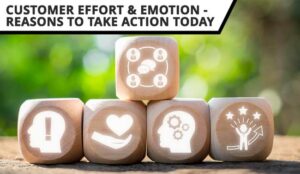Want to be more customer-centric? Megan Jones, Editor at Call Centre Helper, interviewed Katie Stabler of CULTIVATE Customer Experience by Design, and Nate Brown of CX Accelerator about ways to develop a customer-centric mindset in your organization. Here’s what they said…
1. Keep the Customer in the Room
Always keep your customers visible! Of course, this is about the idea of the customer – not the people themselves – and there are some great, creative ways to do this, including:
- Use real-life examples of retrospective customer journeys. Visualize them with paper printouts, showing huge end-to-end journeys that circle around the walls in meeting rooms and corridors that everyone can see every day.
- Bring cardboard printouts of customers into meetings so you can have a customer sitting with you, and then every time a question comes up about the customer experience, you can ask the customer in the room and think about it from their point of view.
- Work with a voice of the customer platform with specialized in audio feedback, where customers can record their audio feedback, and then play this customer feedback to your team. When you can hear the emotion, it elevates it to another level!
Or even just leave an empty seat at the table to represent the customer when you’re having your next meeting. Whatever suits your organization. Just don’t let there be opportunities to lose sight of the customer.
Contributed by: Katie Stabler, Founder and Director of Customer Experience at CULTIVATE Customer Experience by Design
2. Stop Overusing CX Language

Be careful with the language you choose when rolling out CX initiatives. Yes, you want to bang the drum and remind everyone what the CX function does and show its value but remember you’re there to serve the organization.
So, stop using ‘CX’ just for the sake of it – people might tune you out!
Instead, it can help to think about the power of language and how you can reframe the project to bring everyone on board.
For example, instead of introducing yet another new CX project, why not try and switch up your choice of language to use terms like ‘friction fighters’ when trying to spot the hurdles facing customers?
This approach can make a big difference in helping people feel excited and energized about the project in hand.
Contributed by: Nate Brown, Co-Founder of CX Accelerator
3. Translate Your Vision Into a Customer Promise

If you asked many employees in a company ‘what’s your organization’s mission vision?’ very few would be able to successfully answer it.
Yet if people had more ‘skin in the game’, if they felt truly a part of it, it would really support customer centricity.
That’s why it’s so important to make sure that vision mission strategy is visible and supported by everyone in the organization.
How do you achieve this? Invest time in translating your vision as an organization into a customer promise.
Break it down into pillars supported by actions. It all comes down to answering the question ‘what are you going to do to achieve the customer promise?’ so your people understand their role in making it happen.
Contributed by: Katie Stabler, Founder and Director of Customer Experience at CULTIVATE Customer Experience by Design
For more advice on vision statements, take a look at Getting Started With Customer Service Mantras and Vision Statements
4. Align Your Performance Management With Your CX Goals
Performance management can make or break your customer-centricity!
Too often, organizations talk about CX and winning hearts and minds and then… slap some completely different goals over the top that they hold their people (and their pay cheques) accountable to!
So you’ve really got to think about your performance management cycle. Are your people incentivized to be customer-centric or not? It’s about being consistent and not just paying lip service to great CX. It’s all got to work together.
Contributed by: Nate Brown, Co-Founder of CX Accelerator
5. Always Ask Your Frontline Teams for Their Thoughts
Aside from customer themselves, nobody else knows your customer experience better than the people who deliver it. They have great ideas on how to make improvements, so embrace it, encourage it, act on it, and showcase it!
This has the added benefit of supporting the EX/CX loop, creating engaged employees that are more likely to be more efficient and effective and deliver a good customer experience!
Contributed by: Katie Stabler, Founder and Director of Customer Experience at CULTIVATE Customer Experience by Design
6. Put the Spotlight on Voice of Customer Data
Voice of Customer (VOC) is critical when trying to change the mindset of your people so that they behave in a specific way when serving customers.
Why not use it to intrinsically motivate your people so they know the difference that they’re making every day?
It kills me to see some organizations only using VOC data insights to crack the whip on their teams. It’s time to flip this on its head and use that insight to start driving a customer-centric mindset instead!
Contributed by: Nate Brown, Co-Founder of CX Accelerator
If you are looking to improve your VoC programme, read our article: 20 Smart Ideas to Improve Your Voice of the Customer Programme
7. Train Agents to Build Emotional Connections
Building emotional connections through empathetic language, positive reinforcement, and even subtle design cues can significantly alter the perceived experience. Yet many people still tend to look away from this, thinking of it as intangible, subjective, and even fluffy.
Ultimately, if you look at the neuroscience of customer experience, people form memories from emotion.
You want to be memorable as an organization and you’re only going to do that if you can spur an emotion from your customer interactions – be that good or bad, although ideally good.
If you train agents to use the 3 S’s – a framework of Success, Sentiment, and Satisfaction – customers are more likely to remember the experience and it’s going to keep them coming back.
Quite simply, if you can deliver Success in every interaction, Sentiment in every interaction, and Satisfaction in every interaction, you’re going to be more customer-centric.
Contributed by: Katie Stabler, Founder and Director of Customer Experience at CULTIVATE Customer Experience by Design
8. Make the Customer Experience Come to Life
So much customer experience data gets lost in a report on someone’s desk. So why not think about how you can make this insight come to life?
For example, I was once trying to get teams to engage with incident management software, so I planned a scenario where we had the Kool-Aid Man burst into the room and break my arm.
The frontline teams then had to use the software (just as the customer would) to log the incident and experience it for themselves.
Once they’d generated their report, it was their ticket to a free lunch where we gathered to talk about the customer journey.
So, no matter what company you’re in, have some fun, and really bring your products and services to life.
Contributed by: Nate Brown, Co-Founder of CX Accelerator
9. Chase Customer Loyalty – Not Metrics
Metrics have their place (after all, we don’t improve what we don’t measure), but too often the WHY behind the metrics is overlooked when it comes to creating a culture of customer-centricity.
You need to switch it up so you’re not always chasing metrics. Instead, you should ask yourself ‘How do we drive customer loyalty?’ then focus on your customer experience design delivery and continuous improvement to make it happen.
Contributed by: Katie Stabler, Founder and Director of Customer Experience at CULTIVATE Customer Experience by Design
Looking to find out how to spot if your team leaders are chasing metrics? Read our article: Are Your Team Leaders Too Busy Chasing Metrics?
10. Don’t Try to Be All Things to All People
And finally… You can’t be all things to all people!
Success comes down to getting back to the brand’s core, driving excitement and centricity around a targeted demographic that you can serve better than anybody else in the world.
Once you’ve agreed this, you can say, “here’s what it looks like” to help your people deliver on that promise.
Contributed by: Nate Brown, Co-Founder of CX Accelerator
This article features the highlights of a roundtable discussion with Katie Stabler of CULTIVATE Customer Experience by Design, and Nate Brown of CX Accelerator, and Broadcast Music, Inc. (BMI) – hosted by Megan Jones, Editor at Call Centre Helper.
If you want more expert advice on developing your customer service strategy, read these articles next:
- Get Started With Proactive Customer Service
- Expert Strategies to Improve Customer Happiness
- The Key Elements of a CX Lifecycle and Ways to Improve It
- An Introduction to… Total Experience (TX)
Author: Megan Jones
Reviewed by: Xander Freeman
Published On: 3rd Apr 2024 - Last modified: 23rd Oct 2025
Read more about - Customer Service Strategy, Customer Experience (CX), Customer Loyalty, Customer Service, Editor's Picks, Katie Stabler, Nate Brown, Service Strategy, Top Story




















